As space missions to the Earth-moon neighborhood, or the cislunar region, are expected to number in dozens over the next decade, the need for efficient traffic management in this region has become increasingly critical.
Carolin Frueh, an engineer at Purdue University, is leading the charge in this arena, developing methods to observe and monitor all human-made objects in this space. Her work seeks to predict and mitigate potential damage from object collisions in the cislunar region.
“There will never actually be a final answer to a space traffic management problem because as the commercial sector grows and the capabilities and types of vehicles that you have change, the problem will evolve, too,” Frueh, a Purdue associate professor of aeronautics and astronautics, said. “So when we think about the techniques that we want to use, we also have to be sure that what we have in mind can evolve over time.”
The commercial potential of the cislunar space is significant, projected to exceed $30 billion over two decades, factoring in government investment, demand for space telecommunications services, and other elements.
While the distance between Earth and the moon is vast – 238,900 miles, or 18 times the length of the Great Wall of China – the potential for collisions in the cislunar region is very real. This area is less understood than near-Earth orbits, which house most satellites, including well-known ones like the Hubble Space Telescope and International Space Station.
Space debris, totaling approximately 130 million pieces, already surrounds Earth. Much of it has broken off satellites following explosions or collisions. This debris has even reached the moon, as evidenced by a rogue rocket booster crash in March.

In light of the imminent traffic in the cislunar region, Frueh is leveraging her research on spacecraft-to-debris transformation. She collaborates with international space agencies to enhance space object databases.
Monitoring the cislunar space will be challenging due to its expansive nature and the limited visual access from Earth. However, Frueh, in collaboration with her student, Surabhi Bhadauria, is developing ‘visibility maps’ that would highlight the optimal regions for telescopes to detect and track human-made objects in the cislunar region.
“It’s like planning a road trip. Right now, we have identified points of interest in the cislunar region to observe with telescopes, but we haven’t found the route yet for putting the telescopes there,” Frueh said.
Furthermore, Frueh is working on a method that would enable mission planners and researchers to discern the orbits satellites use to execute their missions, even from the limited imagery these satellites present.
Given the inevitability of traffic accidents in the cislunar region, Frueh also considers estimating the potential damage of a collision or explosion crucial. Recent research presented by Frueh and her student, Ariel Black, showed that fragments from a satellite can travel extensive distances in a relatively short timeframe, even reaching back to Earth from deep within the cislunar region.
“We are laying the foundations that we believe will shape how space traffic management problems are addressed in the cislunar region,” Frueh stated, highlighting the importance of her work in this burgeoning field.


